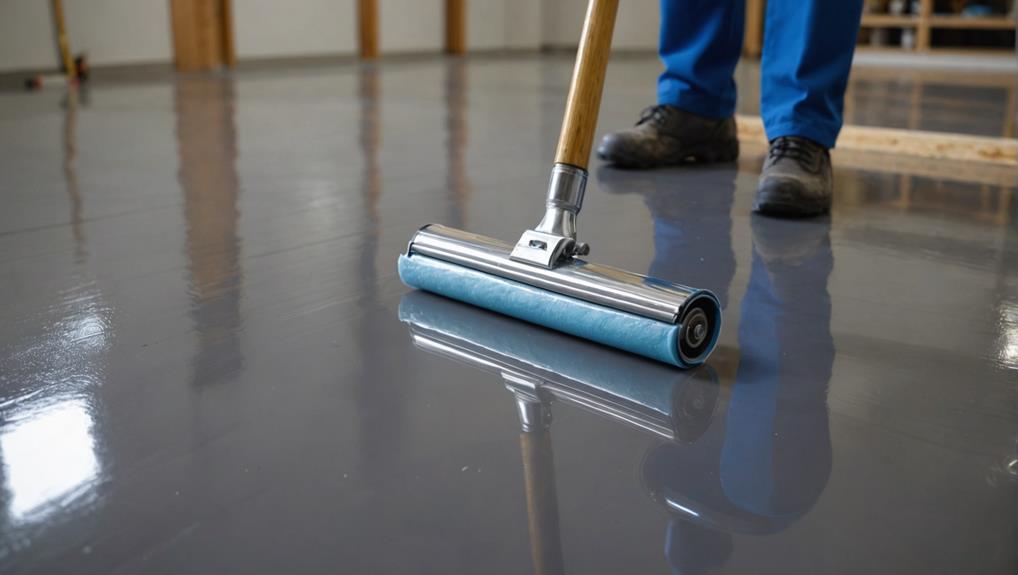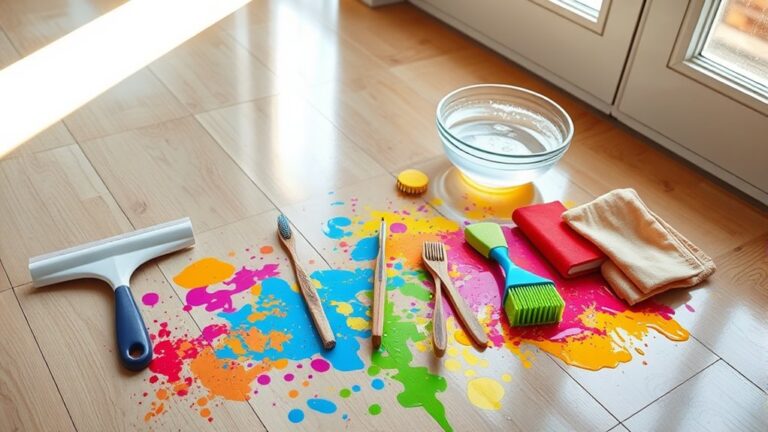To prevent peeling in floor coatings, focus on proper surface preparation and application techniques. Start by cleaning and drying the substrate thoroughly; this guarantees strong adhesion. Use the right type of coating, like epoxy for its durability, and always follow the manufacturer's instructions for mixing and application. Apply coatings at ideal temperatures and humidity levels, ideally between 40% and 60%. Regular inspections are vital; look for any signs of wear or moisture issues early. Finally, address problems promptly to maintain the coating's integrity. There's more to learn about enhancing the longevity of your vloer coatings, so keep exploring.
Understand the Causes of Peeling
To effectively prevent peeling in floor coatings, it's important to understand the underlying causes. One of the primary factors contributing to peeling is moisture intrusion. When moisture penetrates the substrate, it can lead to a breakdown of the adhesive bond between the coating and the surface. This is particularly problematic in areas with high humidity or where water exposure is frequent. It's critical to identify and mitigate sources of moisture before applying any coating.
Another notable cause of peeling is temperature fluctuations. When a floor experiences extreme changes in temperature, it can expand and contract, stressing the coating. If the coating isn't formulated to accommodate these changes, it may crack or separate from the substrate. This issue is especially prevalent in environments with inconsistent heating or cooling, such as warehouses or garages.
To maintain the longevity of your floor coating, you need to maintain a stable environment. Implementing moisture barriers can effectively reduce the risk of moisture intrusion. Additionally, consider using temperature-regulating systems to minimize fluctuations.
Lastly, it's imperative to follow proper application procedures and guidelines for your specific coating type. Verify the surface is clean and dry before application, and allow adequate curing time. By addressing moisture and temperature concerns, you can greatly reduce the risk of peeling and enhance the durability of your floor coatings.
Choose the Right Coating
Choosing the right coating is essential for preventing peeling and guaranteeing the longevity of your floor. One of the first steps in this process is to assess the various coating types available, as each offers distinct properties suitable for different environments. For instance, epoxy coatings are known for their durability and resistance to chemicals, making them ideal for industrial settings. On the other hand, urethane coatings provide flexibility, which can be advantageous in areas with fluctuating temperatures.
It's equally important to take into account surface compatibility when selecting a coating. Not all coatings adhere well to every type of surface. For example, if your floor is concrete, you'll want a coating specifically designed for that substrate. Using a coating that lacks compatibility can lead to poor adhesion, increasing the likelihood of peeling over time. Always consult the manufacturer's specifications to guarantee the coating is suited for your specific surface.
Additionally, think about the environment in which the coating will be applied. If the area is subject to high moisture or temperature changes, you should choose a coating that can withstand these conditions without compromising its integrity.
Prepare the Surface Properly
Properly preparing the surface is essential for guaranteeing the adhesion of your chosen floor coating. This preparation process is fundamental in preventing issues like peeling, which can compromise the integrity and aesthetics of your flooring. Start with thorough surface cleaning; removing dirt, grease, and any contaminants is imperative. Use a suitable cleaner to degrease the surface, and make sure it's rinsed well. If the substrate is porous, consider using a pressure washer for a deeper clean, but allow the surface to dry completely before proceeding.
Once your surface is clean, inspect it for any imperfections such as cracks or holes. Address these issues using appropriate fillers or patching compounds, assuring a uniform surface for the coating to adhere to. After repairs, it's essential to implement substrate priming. Priming enhances the bonding capabilities of the floor coating, especially on porous surfaces. Select a primer that's compatible with your specific coating material for the best results.
Follow Manufacturer Instructions
Adherence to manufacturer instructions is critical for achieving optimal performance and longevity in floor coatings. When you follow the manufacturer guidelines closely, you guarantee that the materials perform as intended, considerably reducing the risk of peeling. Each product comes with specific recommendations for surface preparation, mixing ratios, and application techniques, which are essential for ideal adhesion.
Before starting your project, take the time to read through all the provided instructions thoroughly. This includes understanding the required environmental conditions, such as temperature and humidity levels, which can impact the curing process of the coating. Using the wrong mixing ratios or not allowing adequate curing time can lead to premature failure of the coating.
Moreover, employing the recommended application techniques is crucial. This may involve using specific tools, such as rollers or sprayers, which are designed to apply the coating evenly. Uneven application can create weak spots, making the coating prone to peeling as it ages. Additionally, the manufacturer may specify the number of coats needed and the appropriate drying times between each layer to guarantee proper adhesion.
Ignoring these guidelines not only jeopardizes the coating's integrity but also poses safety risks, particularly in environments where slip resistance is essential. As a result, always maintain strict compliance with manufacturer instructions to achieve the best results and secure a safe, long-lasting floor coating.
Apply Coatings in Ideal Conditions
Creating a strong foundation for your floor coating starts with applying it under ideal conditions. Guaranteeing proper temperature control and adequate ventilation is essential for achieving a durable finish. When you apply coatings in environments that meet specified conditions, you greatly reduce the risk of peeling.
Here's a quick reference table to help you understand the ideal conditions for application:
| Condition | Ideal Range | Impact on Coating |
|---|---|---|
| Temperature | 65°F to 85°F (18°C to 29°C) | Enhances adhesion and curing |
| Humidity | Below 85% | Prevents moisture traps |
| Airflow | Moderate ventilation | Helps with drying time |
| Surface Temperature | Similar to air temp | Guarantees proper curing |
| Application Time | During mild weather | Reduces risks of rapid drying |
Temperature control is critical. If it's too cold, the coating may not cure properly, leading to weak adhesion. Conversely, excessive heat can cause the coating to dry too fast, leading to cracks or peeling.
Ventilation importance cannot be overstated. Adequate airflow minimizes the risk of solvent entrapment and guarantees even distribution of the coating. Without proper ventilation, you're not only risking the integrity of your floor coating but also creating a potentially hazardous environment.
Maintain Proper Humidity Levels
Maintaining the right humidity levels during floor coating application is vital for guaranteeing a successful finish. When humidity levels are too high or too low, it can negatively impact the adhesion and curing of the coating. This can lead to peeling and other surface failures that compromise the integrity of your flooring system.
To achieve ideal results, you need to implement effective humidity control measures. Ideally, the relative humidity should be maintained between 40% and 60% during the application process. This moisture balance helps the coating to cure uniformly and adhere properly to the substrate. If you're working in an environment where humidity fluctuates, consider using dehumidifiers or humidifiers to stabilize the air conditions.
Before you begin, always check the local weather forecast and indoor climate. If the humidity is outside the recommended range, it's best to postpone the application until conditions improve. Additionally, verify that the area is well-ventilated, as this aids in moisture evaporation and promotes even curing.
After application, maintaining proper humidity levels continues to be important. High humidity can slow down the curing process, while low humidity can lead to rapid drying, both of which can result in peeling. By prioritizing humidity control throughout the application and curing phases, you'll greatly reduce the risk of peeling and enhance the longevity of your floor coatings.
Regular Inspection and Maintenance
To guarantee the longevity of your floor coatings, regular inspection and maintenance are essential. By implementing effective inspection techniques, you can identify potential issues before they escalate into considerable problems. Start by visually examining the surface for signs of wear, discoloration, or bubbling. Pay close attention to joints and seams, as these areas are often more susceptible to peeling. Employ a moisture meter to assess humidity levels within the substrate; excessive moisture can weaken the bond of the coating.
Establishing a maintenance schedule is equally important. Depending on the traffic and usage of the area, set up a routine that includes thorough cleaning and periodic re-coating. Regular cleaning not only removes contaminants but also helps in spotting early signs of deterioration. Use pH-neutral cleansers to avoid damaging the coating, and consider employing a soft-bristle brush for scrubbing.
Additionally, document your inspections and maintenance activities. Keeping detailed records will help you track the condition of your floor coatings over time, allowing for informed decisions on when to perform more extensive maintenance or repairs. Make it a practice to conduct inspections at least quarterly, or more frequently in high-traffic areas. By adhering to these practices, you're substantially reducing the likelihood of peeling and ensuring a safer environment for everyone who uses the space. Prioritizing regular inspection and maintenance will ultimately enhance the durability and appearance of your floor coatings, safeguarding your investment.
Address Issues Promptly
To prevent peeling in floor coatings, you need to identify early signs of deterioration during regular inspections. Addressing these issues promptly can save you from more extensive repairs down the line. Timely repair actions not only enhance the longevity of your flooring but also maintain its aesthetic appeal.
Identify Early Signs
How can you spot early signs of peeling in floor coatings before they escalate into a major issue? Identifying peeling symptoms early can save you time and resources. Look out for surface anomalies such as bubbles, discoloration, or flaking. These symptoms often indicate that the bond between the coating and substrate is compromised.
Here's a handy table to help you recognize these signs:
| Peeling Symptoms | Potential Causes |
|---|---|
| Bubbles or Blisters | Moisture trapped beneath |
| Discoloration | UV exposure or chemical damage |
| Flaking or Chipping | Poor surface preparation |
Regularly monitor your floors to catch these signs early. If you notice any of these symptoms, address them promptly to prevent further deterioration. Ignoring surface anomalies can lead to more extensive peeling, which may require significant repairs or replacement of the flooring. Keeping an eye on these indicators helps you maintain the integrity of your floor coatings and guarantees a safer environment. Being proactive is key to preventing costly repairs down the line.
Perform Regular Inspections
Conducting regular inspections of your floor coatings is vital for maintaining their longevity and preventing extensive damage. To achieve this, you should establish an appropriate inspection frequency, ideally conducting assessments every three to six months. This allows you to identify potential issues before they escalate.
Utilizing the right inspection tools is imperative. A moisture meter can help detect moisture levels that may compromise the integrity of the coatings, while a digital caliper can measure thickness variations that indicate wear. Visual inspections should also be thorough; look for signs of delamination, cracking, or discoloration.
During your inspections, make certain you check for areas where the coating may have lifted or separated from the substrate. These early indicators can help you address problems promptly, reducing the risk of more severe peeling.
Timely Repair Actions
Addressing issues promptly is essential for preventing further deterioration of your floor coatings. When you notice signs of wear, such as cracks or peeling, timely interventions can save you from costly repairs down the line. Proactive measures guarantee that minor issues are resolved before they escalate.
Here's a simple table to help you assess what actions to take based on the type of damage:
| Damage Type | Aanbevolen actie | Timeframe |
|---|---|---|
| Minor Peeling | Clean and reapply topcoat | Within 1 week |
| Scheuren | Fill with appropriate filler | Within 1-2 weeks |
| Major Damage | Consult a flooring specialist | Onmiddellijk |
Veelgestelde vragen
How Long Does It Take for Floor Coatings to Dry Completely?
Floor coatings typically take 24 to 72 hours to dry completely, but this can vary based on drying conditions like temperature and humidity. Curing time may extend beyond initial drying, sometimes lasting several days to weeks for peak hardness and durability. For safety, make sure the area is well-ventilated and avoid heavy traffic during this period. Always refer to the manufacturer's guidelines for specific recommendations related to the product you're using.
Can I Apply a New Coat Over Peeling Paint?
Imagine painting a canvas with layers of color, each stroke adding depth. If you see peeling, it's like the paint's crying for help. You shouldn't apply a new coat over peeling paint; it won't adhere properly. First, identify the peeling causes—moisture or poor adhesion might be at play. Use proper application techniques, like scraping and priming, to prepare the surface. Safety's key, so make sure you're working in a well-ventilated area.
What Tools Do I Need for Surface Preparation?
For effective surface preparation, you'll need several essential tools. Start with a pressure washer or scrub brush for thorough surface cleaning to remove dirt and contaminants. A floor scraper or sander is vital for removing old coatings. Don't forget safety gear like gloves and goggles. Finally, a moisture meter can help with substrate inspection, ensuring the surface is dry enough for new coatings. Proper preparation minimizes risks and enhances the durability of your project.
Is It Safe to Apply Coatings During Winter Months?
Applying coatings during winter months can be safe, but you need to take into account temperature considerations and humidity levels. Ideally, you should apply coatings when temperatures are above the manufacturer's recommended range, typically around 50°F (10°C). High humidity can also affect curing. It's crucial to monitor these conditions to guarantee proper adhesion and durability. If conditions aren't favorable, it's best to wait until spring when temperatures and humidity levels stabilize for the best results.
How Can I Tell if My Coating Needs Replacement?
Like a well-tuned engine, your coating needs regular checks to guarantee peak performance. If you notice visible wear, discoloration, or cracking, it's likely time for a replacement. Coating lifespan typically ranges from 5 to 10 years, depending on usage and maintenance. To prolong longevity, follow maintenance tips like regular cleaning and inspections. Ultimately, prioritizing safety means addressing any signs of deterioration promptly to avoid further damage or hazards in your space.




